3804NRS: Community Health Assessment - Inala, Queensland Essay
VerifiedAdded on 2022/08/27
|9
|1891
|14
Essay
AI Summary
This essay presents a community health assessment of Inala, Queensland, focusing on the social determinants of health. Part A analyzes community data, comparing Inala's demographics (gender, age, employment) to state and national levels, highlighting disparities and potential health impacts. Part B delves into social determinants like gender, age, and unemployment, identifying vulnerable groups (males, elderly, unemployed) and prevalent health issues, particularly substance abuse. The essay explores the Addiction Clinical Unit (ACU) and its evidence-based health promotion programs, including pharmacotherapies and psychological interventions. The conclusion emphasizes the importance of understanding health inequities and providing accessible healthcare to vulnerable populations within the Inala community. The essay references relevant literature to support its claims and findings, concluding with a call for improved healthcare accessibility.
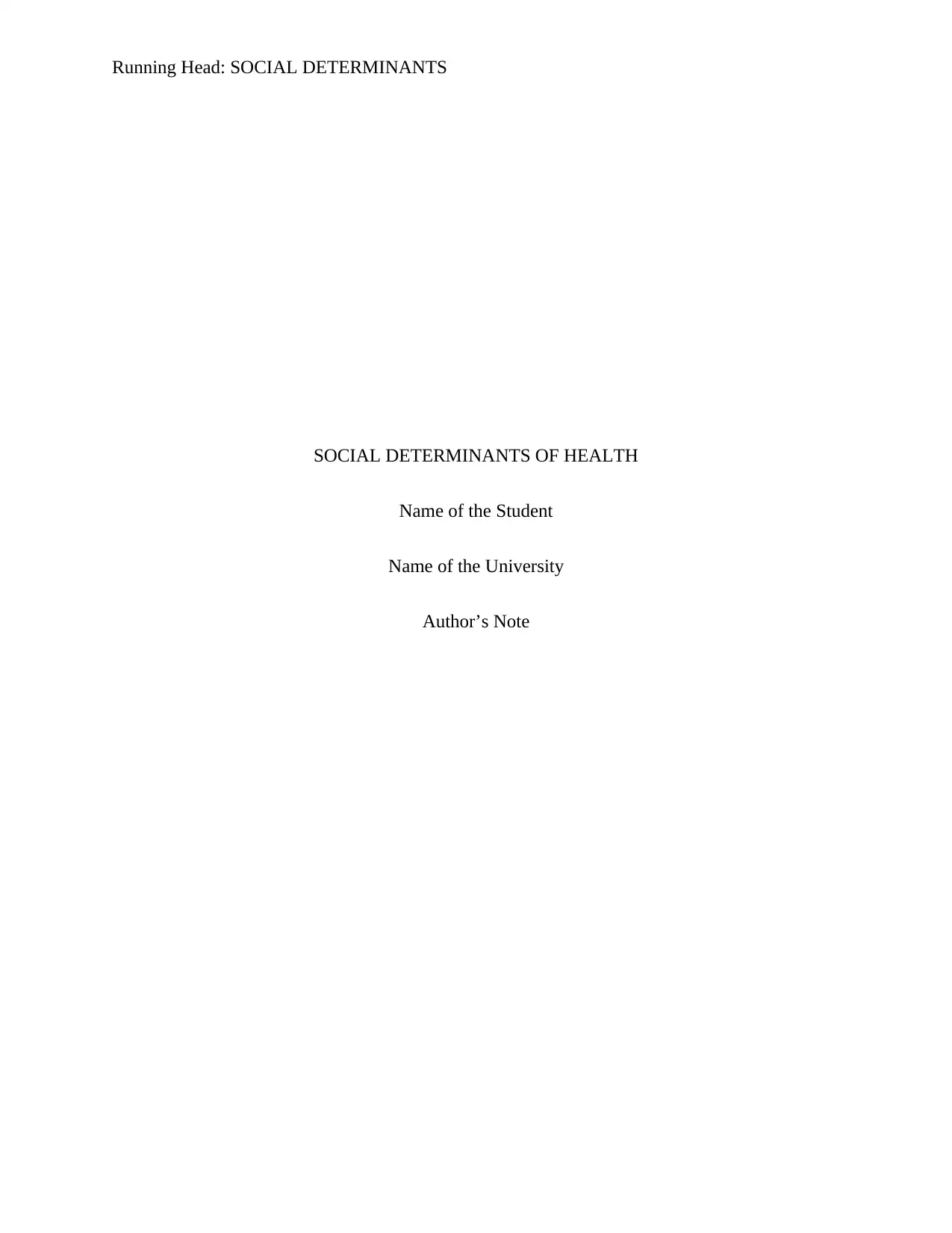
Running Head: SOCIAL DETERMINANTS
SOCIAL DETERMINANTS OF HEALTH
Name of the Student
Name of the University
Author’s Note
SOCIAL DETERMINANTS OF HEALTH
Name of the Student
Name of the University
Author’s Note
Paraphrase This Document
Need a fresh take? Get an instant paraphrase of this document with our AI Paraphraser

1SOCIAL DETERMINANTS
Part A
a. Category/sub-category
of data
b. Summary and
comparative
statement/measures
c. Inference statement
People
Male
The Inala data suggests
51.3% of male with a number
of 29,987 are found in Inala
community. The state data of
Queensland shows 49.4% of
males with a number of
2,321,889 and the national
data shows 49.3% of male
with a number of 11,546,638
is in the whole country.
There is huge difference
between the percentage of
male population in Inala
community and state and
national level. This can have
an impact on the inala
community because males are
susceptible to social and
economic pressure that can
burden them with health
complications.
Part A
a. Category/sub-category
of data
b. Summary and
comparative
statement/measures
c. Inference statement
People
Male
The Inala data suggests
51.3% of male with a number
of 29,987 are found in Inala
community. The state data of
Queensland shows 49.4% of
males with a number of
2,321,889 and the national
data shows 49.3% of male
with a number of 11,546,638
is in the whole country.
There is huge difference
between the percentage of
male population in Inala
community and state and
national level. This can have
an impact on the inala
community because males are
susceptible to social and
economic pressure that can
burden them with health
complications.
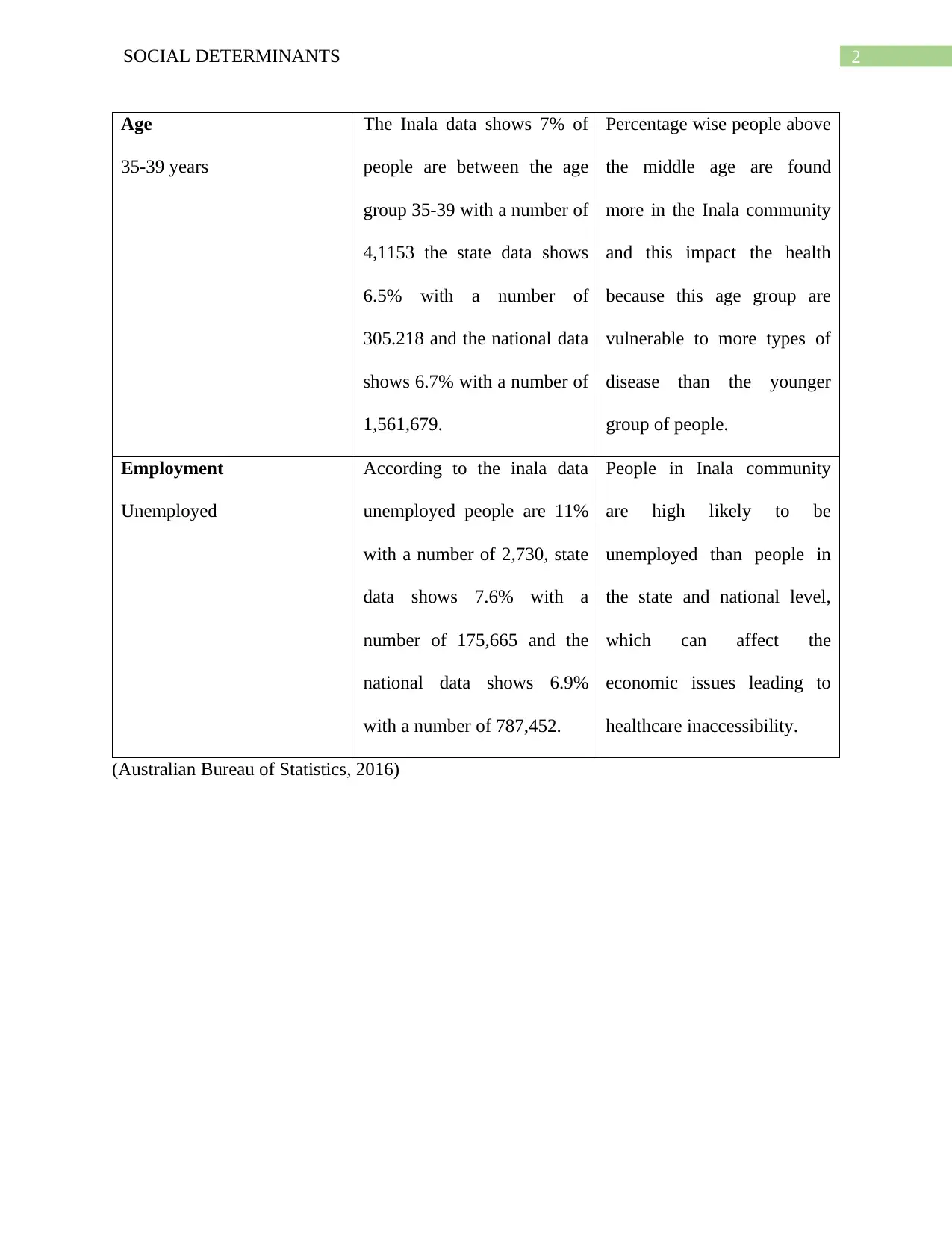
2SOCIAL DETERMINANTS
Age
35-39 years
The Inala data shows 7% of
people are between the age
group 35-39 with a number of
4,1153 the state data shows
6.5% with a number of
305.218 and the national data
shows 6.7% with a number of
1,561,679.
Percentage wise people above
the middle age are found
more in the Inala community
and this impact the health
because this age group are
vulnerable to more types of
disease than the younger
group of people.
Employment
Unemployed
According to the inala data
unemployed people are 11%
with a number of 2,730, state
data shows 7.6% with a
number of 175,665 and the
national data shows 6.9%
with a number of 787,452.
People in Inala community
are high likely to be
unemployed than people in
the state and national level,
which can affect the
economic issues leading to
healthcare inaccessibility.
(Australian Bureau of Statistics, 2016)
Age
35-39 years
The Inala data shows 7% of
people are between the age
group 35-39 with a number of
4,1153 the state data shows
6.5% with a number of
305.218 and the national data
shows 6.7% with a number of
1,561,679.
Percentage wise people above
the middle age are found
more in the Inala community
and this impact the health
because this age group are
vulnerable to more types of
disease than the younger
group of people.
Employment
Unemployed
According to the inala data
unemployed people are 11%
with a number of 2,730, state
data shows 7.6% with a
number of 175,665 and the
national data shows 6.9%
with a number of 787,452.
People in Inala community
are high likely to be
unemployed than people in
the state and national level,
which can affect the
economic issues leading to
healthcare inaccessibility.
(Australian Bureau of Statistics, 2016)
⊘ This is a preview!⊘
Do you want full access?
Subscribe today to unlock all pages.

Trusted by 1+ million students worldwide
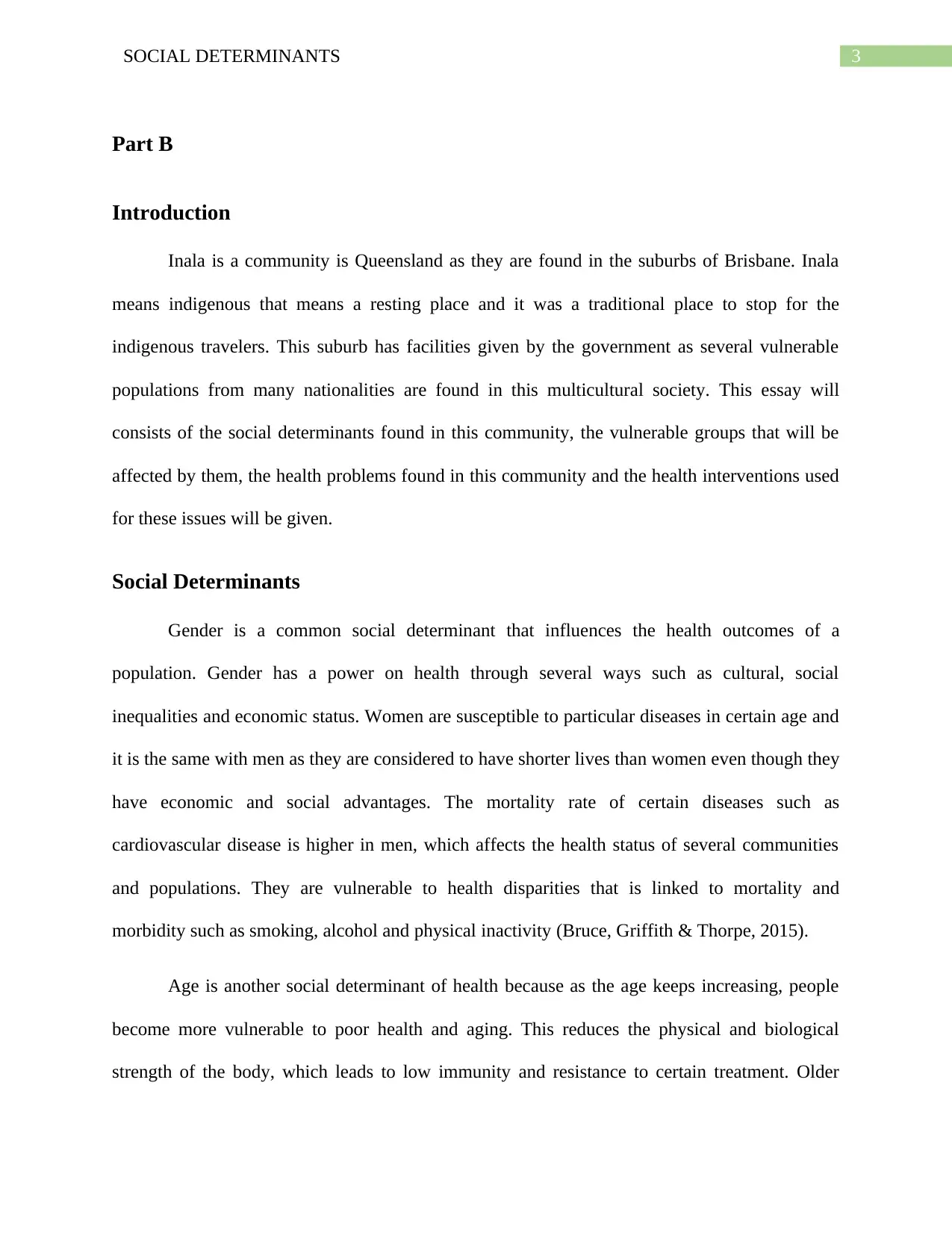
3SOCIAL DETERMINANTS
Part B
Introduction
Inala is a community is Queensland as they are found in the suburbs of Brisbane. Inala
means indigenous that means a resting place and it was a traditional place to stop for the
indigenous travelers. This suburb has facilities given by the government as several vulnerable
populations from many nationalities are found in this multicultural society. This essay will
consists of the social determinants found in this community, the vulnerable groups that will be
affected by them, the health problems found in this community and the health interventions used
for these issues will be given.
Social Determinants
Gender is a common social determinant that influences the health outcomes of a
population. Gender has a power on health through several ways such as cultural, social
inequalities and economic status. Women are susceptible to particular diseases in certain age and
it is the same with men as they are considered to have shorter lives than women even though they
have economic and social advantages. The mortality rate of certain diseases such as
cardiovascular disease is higher in men, which affects the health status of several communities
and populations. They are vulnerable to health disparities that is linked to mortality and
morbidity such as smoking, alcohol and physical inactivity (Bruce, Griffith & Thorpe, 2015).
Age is another social determinant of health because as the age keeps increasing, people
become more vulnerable to poor health and aging. This reduces the physical and biological
strength of the body, which leads to low immunity and resistance to certain treatment. Older
Part B
Introduction
Inala is a community is Queensland as they are found in the suburbs of Brisbane. Inala
means indigenous that means a resting place and it was a traditional place to stop for the
indigenous travelers. This suburb has facilities given by the government as several vulnerable
populations from many nationalities are found in this multicultural society. This essay will
consists of the social determinants found in this community, the vulnerable groups that will be
affected by them, the health problems found in this community and the health interventions used
for these issues will be given.
Social Determinants
Gender is a common social determinant that influences the health outcomes of a
population. Gender has a power on health through several ways such as cultural, social
inequalities and economic status. Women are susceptible to particular diseases in certain age and
it is the same with men as they are considered to have shorter lives than women even though they
have economic and social advantages. The mortality rate of certain diseases such as
cardiovascular disease is higher in men, which affects the health status of several communities
and populations. They are vulnerable to health disparities that is linked to mortality and
morbidity such as smoking, alcohol and physical inactivity (Bruce, Griffith & Thorpe, 2015).
Age is another social determinant of health because as the age keeps increasing, people
become more vulnerable to poor health and aging. This reduces the physical and biological
strength of the body, which leads to low immunity and resistance to certain treatment. Older
Paraphrase This Document
Need a fresh take? Get an instant paraphrase of this document with our AI Paraphraser
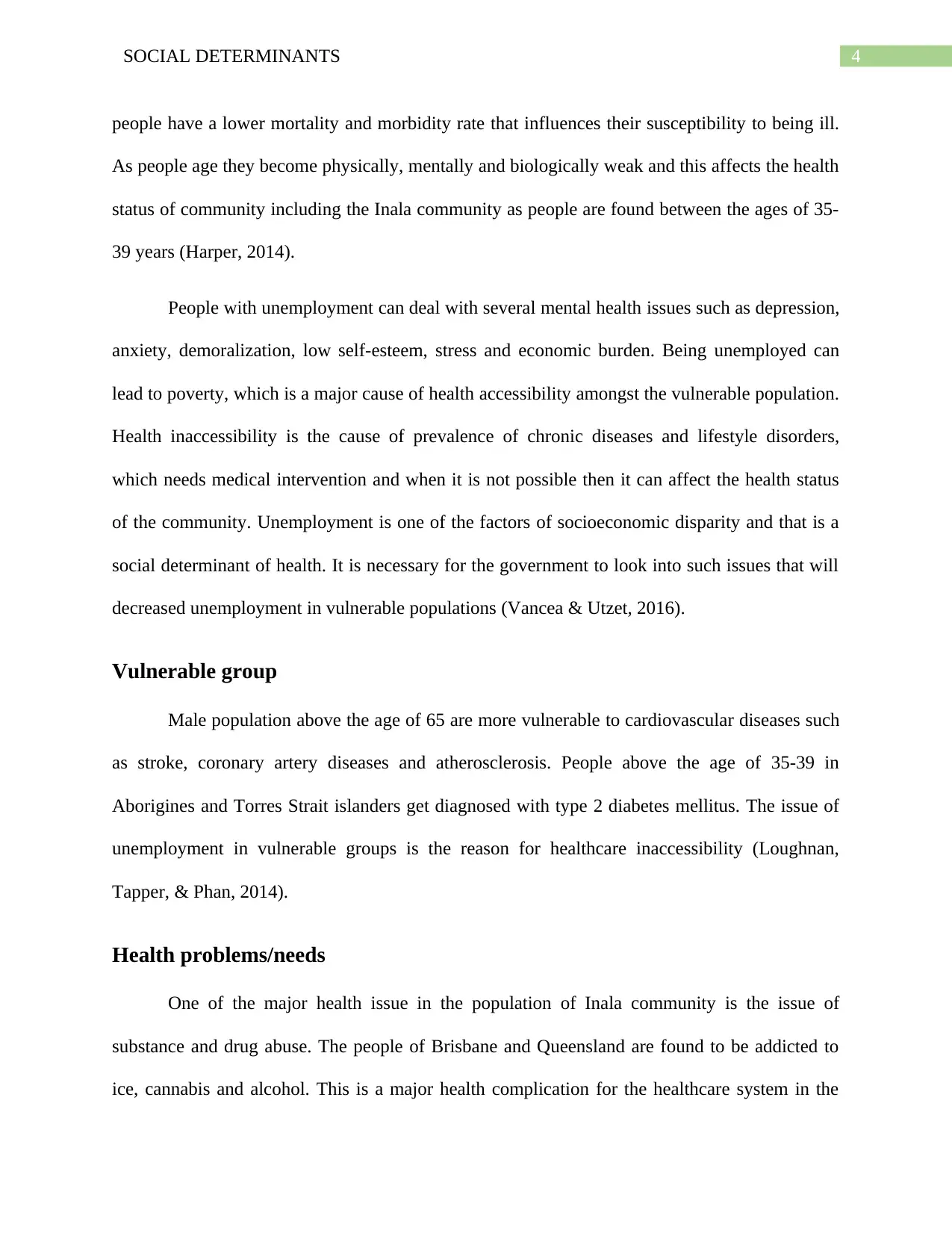
4SOCIAL DETERMINANTS
people have a lower mortality and morbidity rate that influences their susceptibility to being ill.
As people age they become physically, mentally and biologically weak and this affects the health
status of community including the Inala community as people are found between the ages of 35-
39 years (Harper, 2014).
People with unemployment can deal with several mental health issues such as depression,
anxiety, demoralization, low self-esteem, stress and economic burden. Being unemployed can
lead to poverty, which is a major cause of health accessibility amongst the vulnerable population.
Health inaccessibility is the cause of prevalence of chronic diseases and lifestyle disorders,
which needs medical intervention and when it is not possible then it can affect the health status
of the community. Unemployment is one of the factors of socioeconomic disparity and that is a
social determinant of health. It is necessary for the government to look into such issues that will
decreased unemployment in vulnerable populations (Vancea & Utzet, 2016).
Vulnerable group
Male population above the age of 65 are more vulnerable to cardiovascular diseases such
as stroke, coronary artery diseases and atherosclerosis. People above the age of 35-39 in
Aborigines and Torres Strait islanders get diagnosed with type 2 diabetes mellitus. The issue of
unemployment in vulnerable groups is the reason for healthcare inaccessibility (Loughnan,
Tapper, & Phan, 2014).
Health problems/needs
One of the major health issue in the population of Inala community is the issue of
substance and drug abuse. The people of Brisbane and Queensland are found to be addicted to
ice, cannabis and alcohol. This is a major health complication for the healthcare system in the
people have a lower mortality and morbidity rate that influences their susceptibility to being ill.
As people age they become physically, mentally and biologically weak and this affects the health
status of community including the Inala community as people are found between the ages of 35-
39 years (Harper, 2014).
People with unemployment can deal with several mental health issues such as depression,
anxiety, demoralization, low self-esteem, stress and economic burden. Being unemployed can
lead to poverty, which is a major cause of health accessibility amongst the vulnerable population.
Health inaccessibility is the cause of prevalence of chronic diseases and lifestyle disorders,
which needs medical intervention and when it is not possible then it can affect the health status
of the community. Unemployment is one of the factors of socioeconomic disparity and that is a
social determinant of health. It is necessary for the government to look into such issues that will
decreased unemployment in vulnerable populations (Vancea & Utzet, 2016).
Vulnerable group
Male population above the age of 65 are more vulnerable to cardiovascular diseases such
as stroke, coronary artery diseases and atherosclerosis. People above the age of 35-39 in
Aborigines and Torres Strait islanders get diagnosed with type 2 diabetes mellitus. The issue of
unemployment in vulnerable groups is the reason for healthcare inaccessibility (Loughnan,
Tapper, & Phan, 2014).
Health problems/needs
One of the major health issue in the population of Inala community is the issue of
substance and drug abuse. The people of Brisbane and Queensland are found to be addicted to
ice, cannabis and alcohol. This is a major health complication for the healthcare system in the
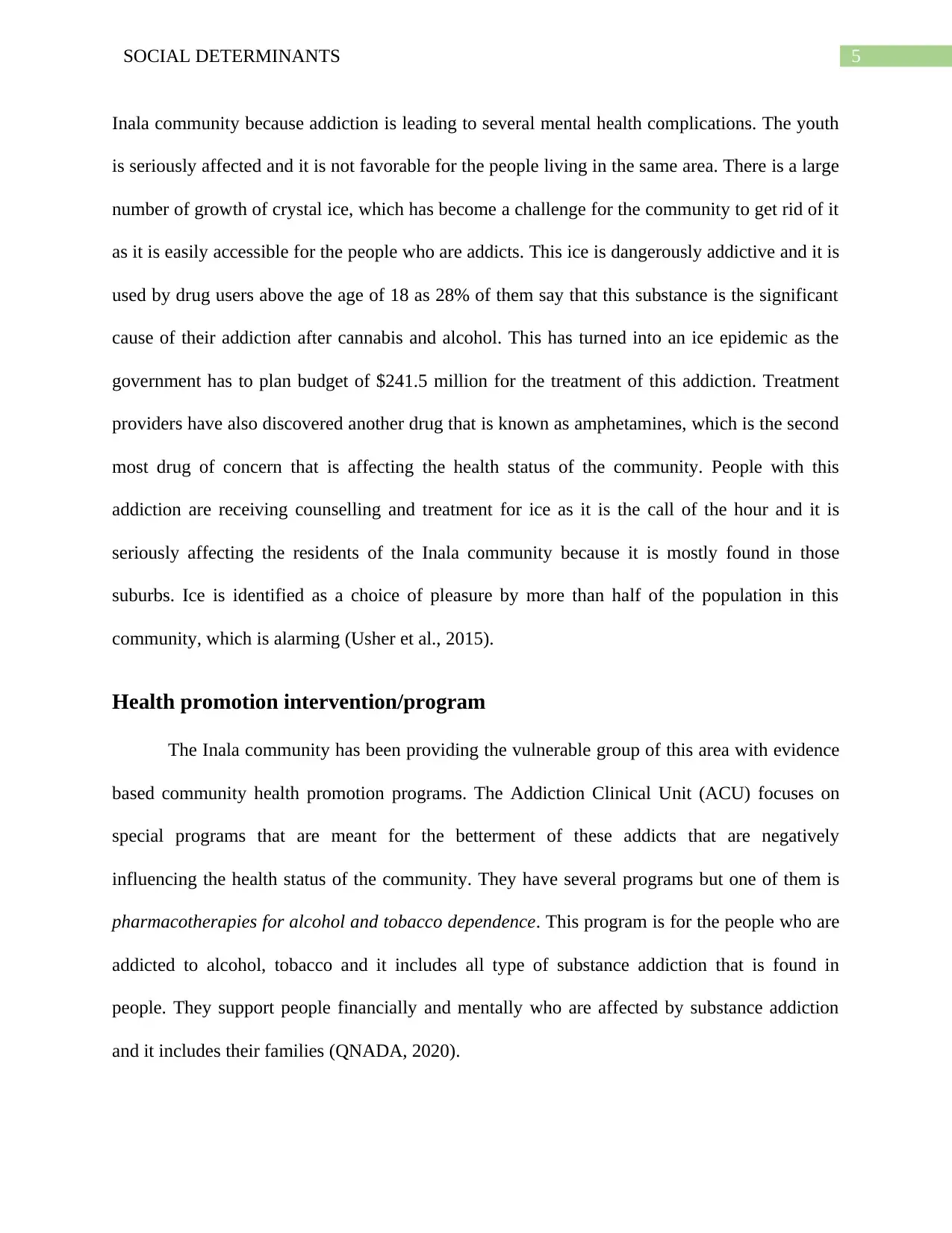
5SOCIAL DETERMINANTS
Inala community because addiction is leading to several mental health complications. The youth
is seriously affected and it is not favorable for the people living in the same area. There is a large
number of growth of crystal ice, which has become a challenge for the community to get rid of it
as it is easily accessible for the people who are addicts. This ice is dangerously addictive and it is
used by drug users above the age of 18 as 28% of them say that this substance is the significant
cause of their addiction after cannabis and alcohol. This has turned into an ice epidemic as the
government has to plan budget of $241.5 million for the treatment of this addiction. Treatment
providers have also discovered another drug that is known as amphetamines, which is the second
most drug of concern that is affecting the health status of the community. People with this
addiction are receiving counselling and treatment for ice as it is the call of the hour and it is
seriously affecting the residents of the Inala community because it is mostly found in those
suburbs. Ice is identified as a choice of pleasure by more than half of the population in this
community, which is alarming (Usher et al., 2015).
Health promotion intervention/program
The Inala community has been providing the vulnerable group of this area with evidence
based community health promotion programs. The Addiction Clinical Unit (ACU) focuses on
special programs that are meant for the betterment of these addicts that are negatively
influencing the health status of the community. They have several programs but one of them is
pharmacotherapies for alcohol and tobacco dependence. This program is for the people who are
addicted to alcohol, tobacco and it includes all type of substance addiction that is found in
people. They support people financially and mentally who are affected by substance addiction
and it includes their families (QNADA, 2020).
Inala community because addiction is leading to several mental health complications. The youth
is seriously affected and it is not favorable for the people living in the same area. There is a large
number of growth of crystal ice, which has become a challenge for the community to get rid of it
as it is easily accessible for the people who are addicts. This ice is dangerously addictive and it is
used by drug users above the age of 18 as 28% of them say that this substance is the significant
cause of their addiction after cannabis and alcohol. This has turned into an ice epidemic as the
government has to plan budget of $241.5 million for the treatment of this addiction. Treatment
providers have also discovered another drug that is known as amphetamines, which is the second
most drug of concern that is affecting the health status of the community. People with this
addiction are receiving counselling and treatment for ice as it is the call of the hour and it is
seriously affecting the residents of the Inala community because it is mostly found in those
suburbs. Ice is identified as a choice of pleasure by more than half of the population in this
community, which is alarming (Usher et al., 2015).
Health promotion intervention/program
The Inala community has been providing the vulnerable group of this area with evidence
based community health promotion programs. The Addiction Clinical Unit (ACU) focuses on
special programs that are meant for the betterment of these addicts that are negatively
influencing the health status of the community. They have several programs but one of them is
pharmacotherapies for alcohol and tobacco dependence. This program is for the people who are
addicted to alcohol, tobacco and it includes all type of substance addiction that is found in
people. They support people financially and mentally who are affected by substance addiction
and it includes their families (QNADA, 2020).
⊘ This is a preview!⊘
Do you want full access?
Subscribe today to unlock all pages.

Trusted by 1+ million students worldwide
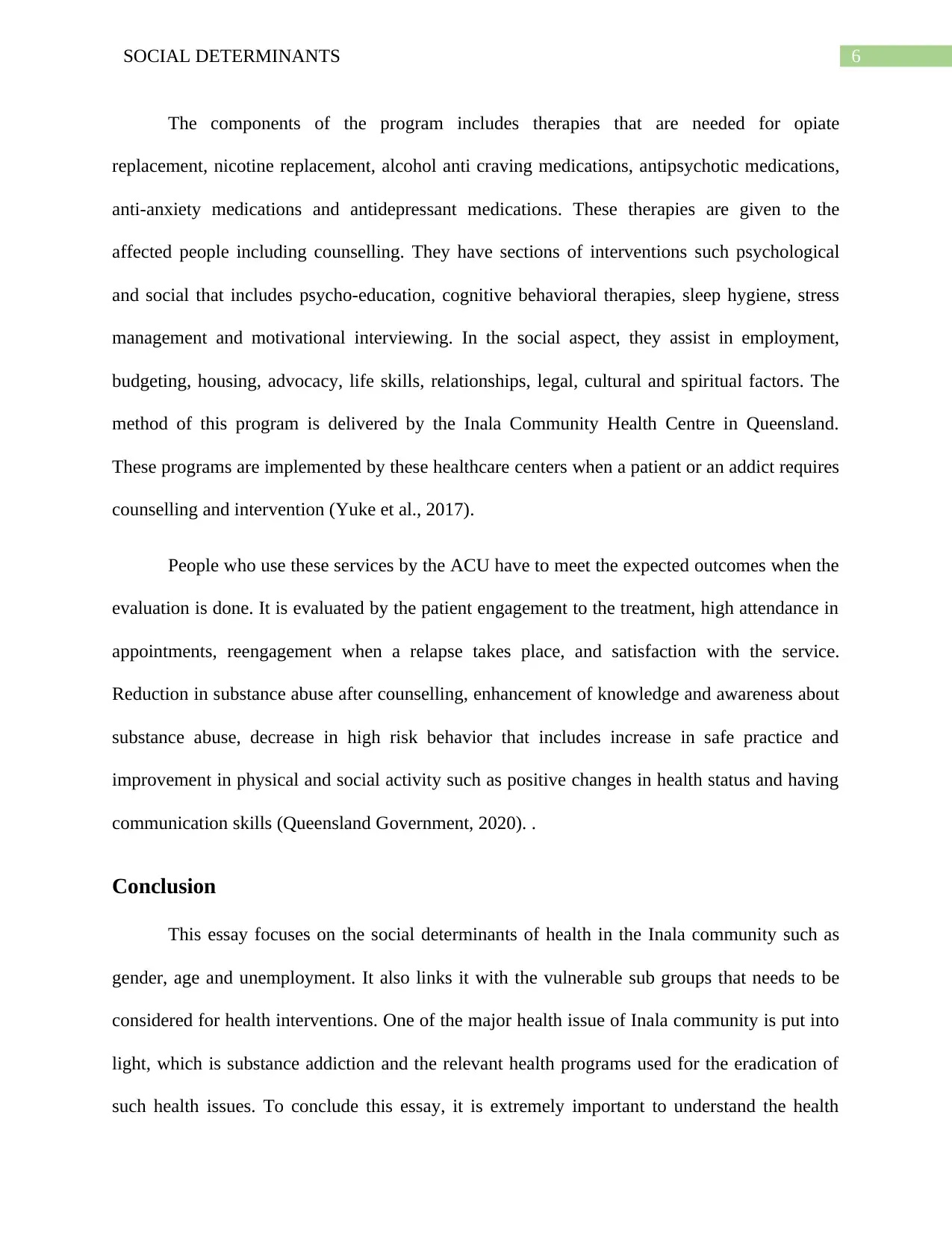
6SOCIAL DETERMINANTS
The components of the program includes therapies that are needed for opiate
replacement, nicotine replacement, alcohol anti craving medications, antipsychotic medications,
anti-anxiety medications and antidepressant medications. These therapies are given to the
affected people including counselling. They have sections of interventions such psychological
and social that includes psycho-education, cognitive behavioral therapies, sleep hygiene, stress
management and motivational interviewing. In the social aspect, they assist in employment,
budgeting, housing, advocacy, life skills, relationships, legal, cultural and spiritual factors. The
method of this program is delivered by the Inala Community Health Centre in Queensland.
These programs are implemented by these healthcare centers when a patient or an addict requires
counselling and intervention (Yuke et al., 2017).
People who use these services by the ACU have to meet the expected outcomes when the
evaluation is done. It is evaluated by the patient engagement to the treatment, high attendance in
appointments, reengagement when a relapse takes place, and satisfaction with the service.
Reduction in substance abuse after counselling, enhancement of knowledge and awareness about
substance abuse, decrease in high risk behavior that includes increase in safe practice and
improvement in physical and social activity such as positive changes in health status and having
communication skills (Queensland Government, 2020). .
Conclusion
This essay focuses on the social determinants of health in the Inala community such as
gender, age and unemployment. It also links it with the vulnerable sub groups that needs to be
considered for health interventions. One of the major health issue of Inala community is put into
light, which is substance addiction and the relevant health programs used for the eradication of
such health issues. To conclude this essay, it is extremely important to understand the health
The components of the program includes therapies that are needed for opiate
replacement, nicotine replacement, alcohol anti craving medications, antipsychotic medications,
anti-anxiety medications and antidepressant medications. These therapies are given to the
affected people including counselling. They have sections of interventions such psychological
and social that includes psycho-education, cognitive behavioral therapies, sleep hygiene, stress
management and motivational interviewing. In the social aspect, they assist in employment,
budgeting, housing, advocacy, life skills, relationships, legal, cultural and spiritual factors. The
method of this program is delivered by the Inala Community Health Centre in Queensland.
These programs are implemented by these healthcare centers when a patient or an addict requires
counselling and intervention (Yuke et al., 2017).
People who use these services by the ACU have to meet the expected outcomes when the
evaluation is done. It is evaluated by the patient engagement to the treatment, high attendance in
appointments, reengagement when a relapse takes place, and satisfaction with the service.
Reduction in substance abuse after counselling, enhancement of knowledge and awareness about
substance abuse, decrease in high risk behavior that includes increase in safe practice and
improvement in physical and social activity such as positive changes in health status and having
communication skills (Queensland Government, 2020). .
Conclusion
This essay focuses on the social determinants of health in the Inala community such as
gender, age and unemployment. It also links it with the vulnerable sub groups that needs to be
considered for health interventions. One of the major health issue of Inala community is put into
light, which is substance addiction and the relevant health programs used for the eradication of
such health issues. To conclude this essay, it is extremely important to understand the health
Paraphrase This Document
Need a fresh take? Get an instant paraphrase of this document with our AI Paraphraser

7SOCIAL DETERMINANTS
inequities certain vulnerable groups are exposed to because they are not accessible to proper
healthcare.
References
Bruce, M., Griffith, D., & Thorpe, R. (2015). Social Determinants of Menʼs Health
Disparities. Family & Community Health, 38(4), 281-283.
https://doi.org/10.1097/fch.0000000000000083
Harper, S. (2014). Economic and social implications of aging societies. Science, 346(6209), 587-
591. https://doi.org/10.1126/science.1254405
Loughnan, M., Tapper, N., & Phan, T. (2014). Identifying Vulnerable Populations in Subtropical
Brisbane, Australia: A Guide for Heatwave Preparedness and Health Promotion. ISRN
Epidemiology, 2014, 1-12. https://doi.org/10.1155/2014/821759
QNADA. (2020). QNADA - Inala Community Health Centre. QNADA. Retrieved 21 March
2020, from https://qnada.org.au/location/inala-community-health-centre/#.
Queensland Government. (2020). Clinical Service Plan [Ebook] (1st ed.). Addiction Services
Academic Clinical Unit. Retrieved 21 March 2020, from
https://metrosouth.health.qld.gov.au/sites/default/files/content/msamhs-addiction-service-
plan.pdf.
Usher, K., Clough, A., Woods, C., & Robertson, J. (2015). Is there an ice epidemic in
Australia?. International Journal Of Mental Health Nursing, 24(4), 283-285.
https://doi.org/10.1111/inm.12155
inequities certain vulnerable groups are exposed to because they are not accessible to proper
healthcare.
References
Bruce, M., Griffith, D., & Thorpe, R. (2015). Social Determinants of Menʼs Health
Disparities. Family & Community Health, 38(4), 281-283.
https://doi.org/10.1097/fch.0000000000000083
Harper, S. (2014). Economic and social implications of aging societies. Science, 346(6209), 587-
591. https://doi.org/10.1126/science.1254405
Loughnan, M., Tapper, N., & Phan, T. (2014). Identifying Vulnerable Populations in Subtropical
Brisbane, Australia: A Guide for Heatwave Preparedness and Health Promotion. ISRN
Epidemiology, 2014, 1-12. https://doi.org/10.1155/2014/821759
QNADA. (2020). QNADA - Inala Community Health Centre. QNADA. Retrieved 21 March
2020, from https://qnada.org.au/location/inala-community-health-centre/#.
Queensland Government. (2020). Clinical Service Plan [Ebook] (1st ed.). Addiction Services
Academic Clinical Unit. Retrieved 21 March 2020, from
https://metrosouth.health.qld.gov.au/sites/default/files/content/msamhs-addiction-service-
plan.pdf.
Usher, K., Clough, A., Woods, C., & Robertson, J. (2015). Is there an ice epidemic in
Australia?. International Journal Of Mental Health Nursing, 24(4), 283-285.
https://doi.org/10.1111/inm.12155
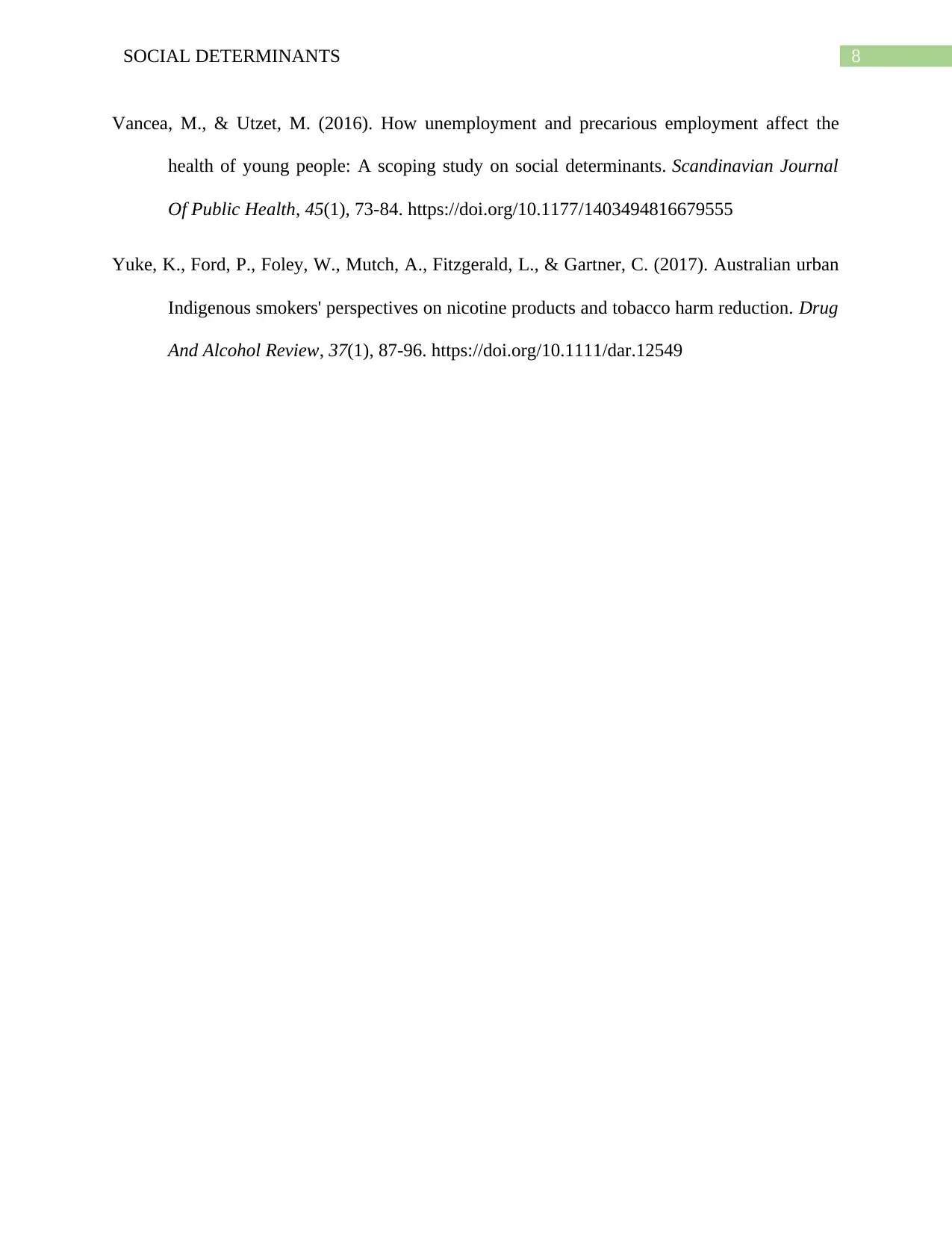
8SOCIAL DETERMINANTS
Vancea, M., & Utzet, M. (2016). How unemployment and precarious employment affect the
health of young people: A scoping study on social determinants. Scandinavian Journal
Of Public Health, 45(1), 73-84. https://doi.org/10.1177/1403494816679555
Yuke, K., Ford, P., Foley, W., Mutch, A., Fitzgerald, L., & Gartner, C. (2017). Australian urban
Indigenous smokers' perspectives on nicotine products and tobacco harm reduction. Drug
And Alcohol Review, 37(1), 87-96. https://doi.org/10.1111/dar.12549
Vancea, M., & Utzet, M. (2016). How unemployment and precarious employment affect the
health of young people: A scoping study on social determinants. Scandinavian Journal
Of Public Health, 45(1), 73-84. https://doi.org/10.1177/1403494816679555
Yuke, K., Ford, P., Foley, W., Mutch, A., Fitzgerald, L., & Gartner, C. (2017). Australian urban
Indigenous smokers' perspectives on nicotine products and tobacco harm reduction. Drug
And Alcohol Review, 37(1), 87-96. https://doi.org/10.1111/dar.12549
⊘ This is a preview!⊘
Do you want full access?
Subscribe today to unlock all pages.

Trusted by 1+ million students worldwide
1 out of 9
Related Documents
Your All-in-One AI-Powered Toolkit for Academic Success.
+13062052269
info@desklib.com
Available 24*7 on WhatsApp / Email
![[object Object]](/_next/static/media/star-bottom.7253800d.svg)
Unlock your academic potential
Copyright © 2020–2025 A2Z Services. All Rights Reserved. Developed and managed by ZUCOL.





